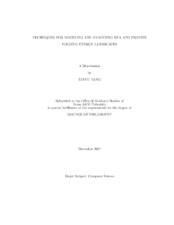| dc.description.abstract | RNA and protein molecules undergo a dynamic folding process that is important
to their function. Computational methods are critical for studying this folding pro-
cess because it is difficult to observe experimentally. In this work, we introduce
new computational techniques to study RNA and protein energy landscapes, includ-
ing a method to approximate an RNA energy landscape with a coarse graph (map)
and new tools for analyzing graph-based approximations of RNA and protein energy
landscapes. These analysis techniques can be used to study RNA and protein fold-
ing kinetics such as population kinetics, folding rates, and the folding of particular
subsequences. In particular, a map-based Master Equation (MME) method can be
used to analyze the population kinetics of the maps, while another map analysis tool,
map-based Monte Carlo (MMC) simulation, can extract stochastic folding pathways
from the map.
To validate the results, I compared our methods with other computational meth-
ods and with experimental studies of RNA and protein. I first compared our MMC
and MME methods for RNA with other computational methods working on the com-
plete energy landscape and show that the approximate map captures the major fea-
tures of a much larger (e.g., by orders of magnitude) complete energy landscape.
Moreover, I show that the methods scale well to large molecules, e.g., RNA with 200+ nucleotides. Then, I correlate the computational results with experimental
findings. I present comparisons with two experimental cases to show how I can pre-
dict kinetics-based functional rates of ColE1 RNAII and MS2 phage RNA and their
mutants using our MME and MMC tools respectively. I also show that the MME
and MMC tools can be applied to map-based approximations of protein energy energy
landscapes and present kinetics analysis results for several proteins. | en |


